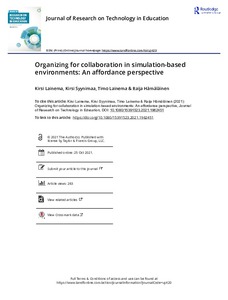Organizing for collaboration in simulation-based environments: An affordance perspective
Lainema Kirsi; Syynimaa Kirsi; Lainema Timo; Hämäläinen Raija
Organizing for collaboration in simulation-based environments: An affordance perspective
Lainema Kirsi
Syynimaa Kirsi
Lainema Timo
Hämäläinen Raija
Taylor & Francis
Julkaisun pysyvä osoite on:
https://urn.fi/URN:NBN:fi-fe2021120859691
https://urn.fi/URN:NBN:fi-fe2021120859691
Tiivistelmä
Extant research has identified the significance of technological affordances in computer-supported learning environments. However, until recently, there is scarcely empirical research on affordances for organizing collaboration in these learning environments. To address this gap, this study empirically examines affordances for organizing collaboration in a simulation-based learning environment. We focus, in particular on understanding how the organizing affordances of the learning environment are perceived and employed by the learners during a simulation-based learning task. The study was executed among 177 undergraduate higher education (HE) business students from 10 universities in Belgium, China, Estonia, New Zealand, the USA, Austria, and Finland. The data were obtained from the students' reflective essays, and analyzed with a qualitative content analytical approach. The results of our analyses yield in four types of organizing affordances: (1) organizing the division of work, (2) managing information and resources, (3) managing tasks, and (4) strategizing. Each type of organizing affordance was required in the joint learning task. The study offers an advanced understanding of affordances for organizing and of their use/nonuse in simulation-based learning environments. The findings of this study have theoretical and empirical implications and can contribute to both the development of pedagogic and educational practices as well as the design of learning tasks and environments.
Kokoelmat
- Rinnakkaistallenteet [27094]
